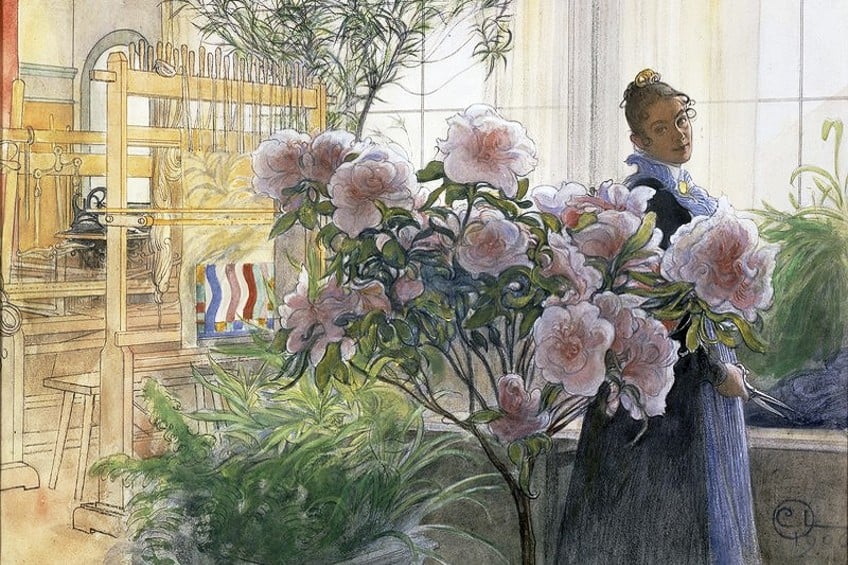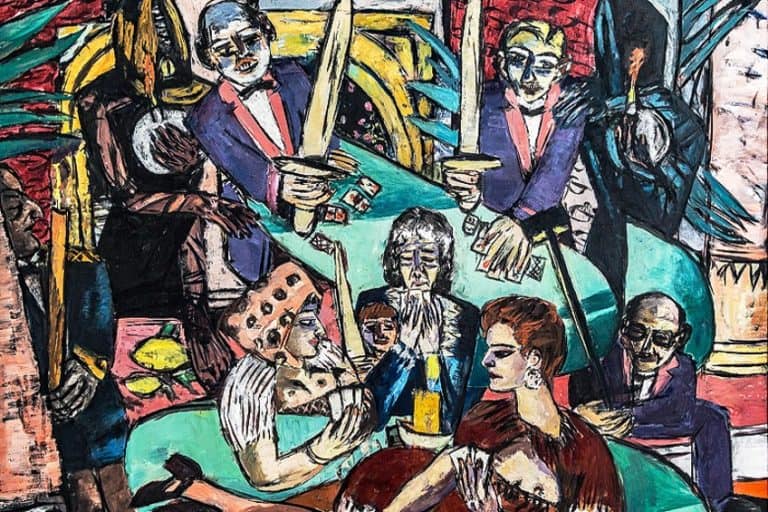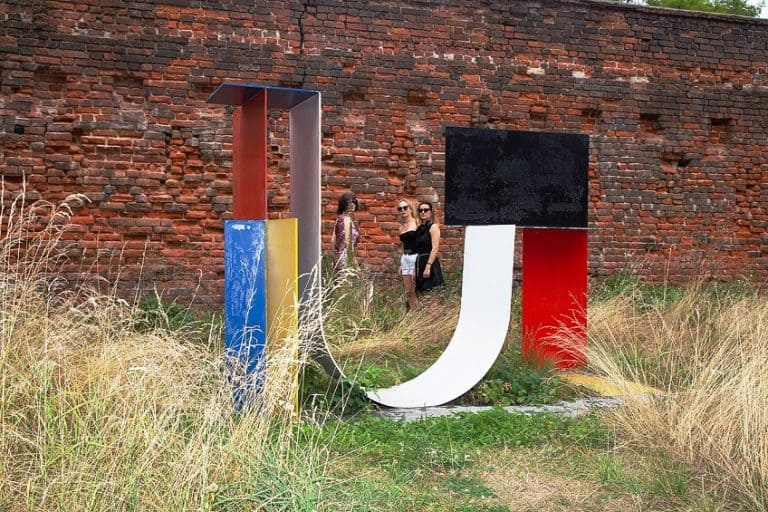Carl Larsson – A Quick Look at the Swedish Painter
Carl Larsson was a renowned Swedish painter and interior designer, celebrated for his idyllic depictions of domestic life and the Swedish countryside. His distinctive style, characterized by bright colors and a keen attention to detail, captured the essence of Swedish folk culture and daily life in the late 19th and early 20th centuries. Larsson’s watercolor paintings, particularly those of his home in Sundborn, gained widespread acclaim, influencing both contemporary and later Scandinavian design aesthetics. His works, deeply personal and often featuring his family, offer an intimate glimpse into his world, merging art with the warmth of home and nature.
Key Takeaways
- Carl Larsson depicted idyllic family life through watercolors.
- Midvinterblot is a notable masterpiece in Swedish art.
- His home, Carl Larsson-gården, showcases his and his wife’s artistic collaboration.
Early Life and Education
| Birth | May 28, 1853 |
|---|---|
| Death | January 22, 1919 |
| Place of Birth | Stockholm, Sweden |
| Genre of Work | Watercolor paintings, illustrations, and interior design |
Carl Larsson, an iconic figure in Swedish art, is renowned for his enchanting watercolors that vividly depict idyllic family life. He was a central figure in the Arts and Crafts movement and his works often featured his wife, Karin, and their eight children, reflecting a serene and wholesome domestic environment. Born in 1853, Larsson’s artistic journey took him to the French artists’ colony in Grez-sur-Loing, where he transformed his style and found inspiration in the natural world around him.
Larsson’s masterpiece, Midvinterblot, remains a pivotal work in Swedish cultural history, showcasing his talent in large-scale fresco painting.
His artistry extended beyond canvas as he famously decorated Sweden’s National Museum, merging folk art inspiration with sophisticated design. Visitors to Carl Larsson-gården, his home in Sundborn, can still witness the unique and charming interiors designed by both Carl and Karin, which remain a testament to their artistic collaboration and influence.
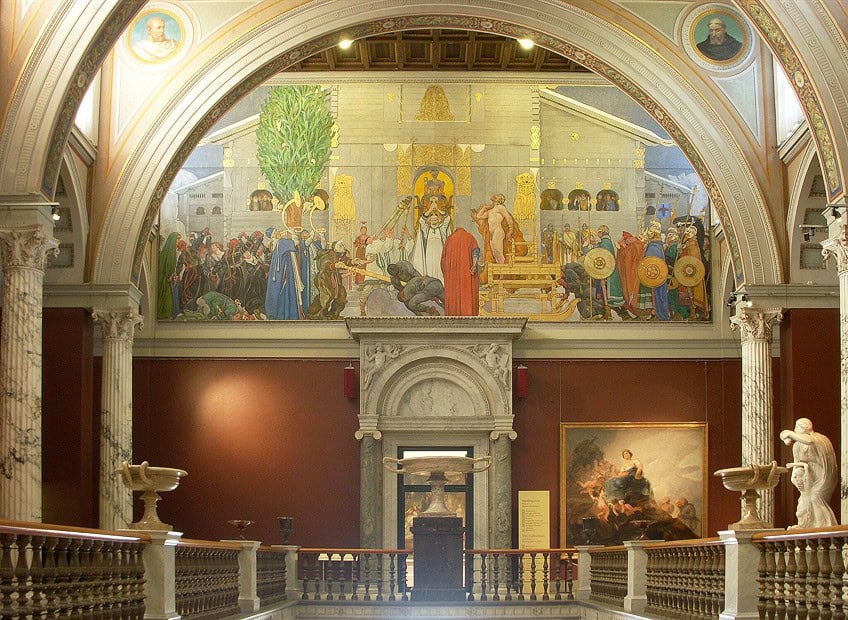
Larsson’s influence on Swedish art and culture remains enduring, as his works continue to captivate audiences with their warmth and intimate portrayal of family life. Whether through his delicate watercolors or grandiose murals, Carl Larsson has left an indelible mark on the art world, celebrating the harmonious blend of artistry and everyday moments.
Beginnings in Stockholm
Carl Larsson was born on May 28, 1853, in the Gamla stan neighborhood of Stockholm, Sweden. Raised in a poor family, Carl faced significant challenges from a young age. His mother, along with Carl and his brother Johan, experienced difficult living conditions, including being thrown out of their home. Despite these hardships, Carl’s artistic abilities were evident early on.
At thirteen, a teacher encouraged him to apply to the Royal Swedish Academy of Arts.
Studies at the Royal Swedish Academy of Arts
Carl Larsson received a scholarship to study at the Royal Swedish Academy of Arts in Stockholm, which marked a turning point in his life. The Academy provided rigorous training in various artistic techniques and styles. Larsson excelled and gradually built a reputation for himself.

His time there not only honed his skills but also connected him with prominent artists and mentors who would shape his career. Although the early struggles persisted, the Academy’s influence was crucial in Larsson’s artistic development.
Influence of Paris and Grez-sur-Loing
In 1877, Carl Larsson moved to Paris, seeking broader artistic horizons. Paris, the epicenter of the art world, exposed him to new ideas and styles. It was also during this period that he frequented the artist colony in Grez-sur-Loing, where he met and interacted with other artists.
This rural setting provided a stark contrast to Paris and influenced his work deeply.
Here, he met Karin Bergoo, who would become his wife in 1883, adding another layer of inspiration and support to his art. The experiences in Paris and Grez-sur-Loing refined Larsson’s unique style, blending traditional Swedish elements with contemporary trends.
Artistic Career
Carl Larsson, a prominent Swedish painter and illustrator, is best known for his work in watercolors, his contributions to public art projects, and his role in the Arts and Crafts Movement. His career spanned various forms of artistic expression, leading to numerous significant accomplishments.
Transition to Watercolors
Carl Larsson initially started with oils but transitioned to watercolors, where he found his unique voice. Watercolors allowed him to capture the subtleties of light and to depict serene scenes of family life. These pieces resonated deeply with people and became his signature style. Through watercolors, Larsson portrayed idyllic domestic environments, particularly scenes from his own home. This approach made his work more relatable and accessible, enhancing his popularity.
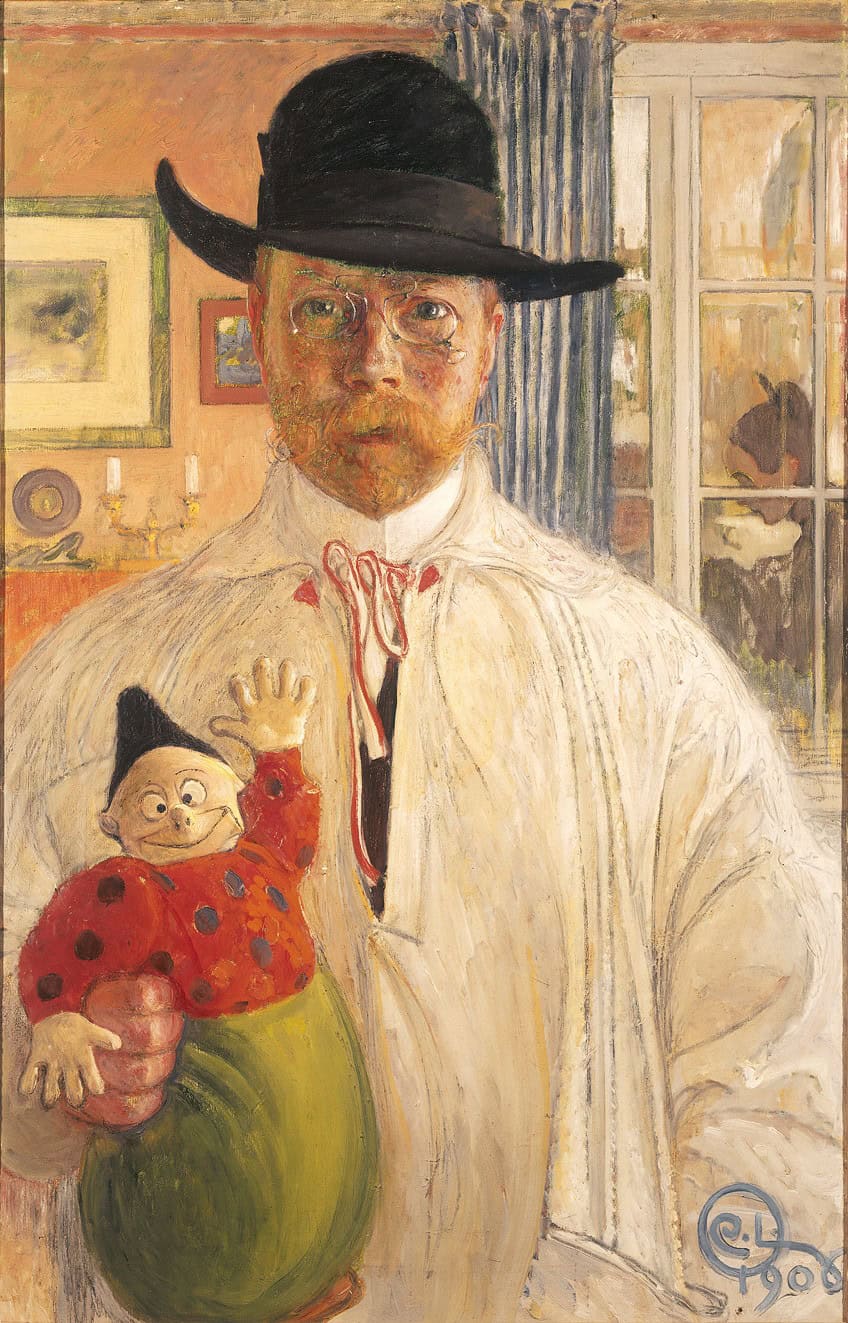
Accomplishments as an Illustrator
Larsson was also a successful illustrator, contributing to magazines and books. His role as a graphic artist was marked by detailed and imaginative illustrations that complemented various literary works. He provided drawings for children’s books and fairy tales, showcasing his talent in blending text with visual art.
His ability to bring stories to life through illustration made him a sought-after figure in the publishing industry.
Frescoes and Public Works
In addition to his watercolors and illustrations, Larsson completed several large-scale frescoes. His most notable work, Midvinterblot (Midwinter Sacrifice), is displayed at the Swedish National Museum of Fine Arts. This fresco depicted a dramatic historical scene and is considered one of his masterpieces.
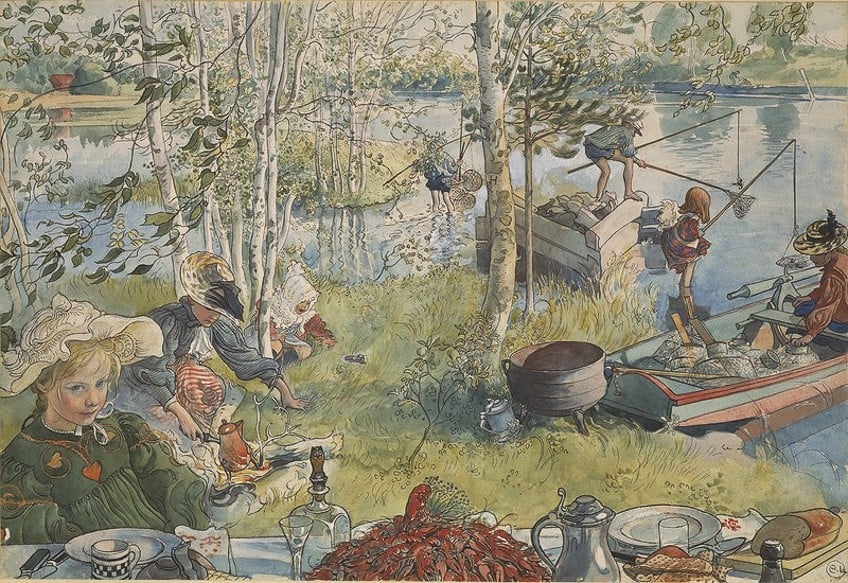
He also created frescoes for public buildings, including the Stockholm Opera foyer. These public works cemented his reputation as an artist capable of blending narrative depth with visual splendor, enriching the cultural fabric of Sweden.
Relation With the Arts and Crafts Movement
Carl Larsson’s involvement in the Arts and Crafts Movement showcased his commitment to integrating art into everyday life. This movement sought to counteract the industrialization of art by promoting craftsmanship and design quality.
Larsson’s work reflected these ideals through his detailed home scenes, emphasizing simplicity and function.
His art served as a model of how beauty could coexist with daily living, aligning perfectly with the Arts and Crafts ethos. By remaining true to the movement’s principles, Carl Larsson influenced a generation of artists and craftspeople, emphasizing the importance of aesthetic harmony in both art and life.
Personal Life and Family
Carl Larsson’s personal life was marked by his marriage to Karin Bergöö and their move to Sundborn, which became a central theme in his art. His family, especially his children, played a significant role in his work, often depicted in various scenes of everyday life.
Marriage to Karin Bergöö
Carl Larsson met Karin Bergöö, an artist in her own right, in Gretz-sur-Loing, France, in 1882. They married in 1883. Their partnership was profound both personally and professionally. Karin, later known as Karin Larsson, significantly influenced Carl’s work, and her sense of design and aesthetics can be seen in many of his interiors.

Their relationship was built on mutual respect and shared artistic pursuits. Both contributed to the unique style of their home, Carl Larsson-Gården, which reflects their creative collaboration. This home became a canvas for Carl’s artwork and a showcase for Karin’s textile designs.
The Larsson Family Dynamics
The Larssons had eight children, which brought both joy and sorrow to the family. Their children—Suzanne, Ulf, Pontus, Lisbeth, Brita, Mats, Kersti, and Esbjorn—often appeared in Carl’s paintings. Tragically, their son Ulf passed away as an infant. Family life at Carl Larsson-Gården in Sundborn was a central subject in Carl’s work. His paintings of family gatherings, everyday moments, and idyllic scenes reflect the warmth and vibrancy of their home life.
Karin’s role as a mother and artistic contributor is evident in the harmony portrayed in these works.
Life in Sundborn
In 1888, the Larsson family moved to Sundborn, where they lived in a house gifted by Karin’s father. This home, now known as Carl Larsson-Gården, became a creative hub. The house not only served as their residence but also as a synthesis of their artistic vision.

Sundborn’s picturesque landscapes often featured in Carl’s watercolors. This home was a focal point for the family and their friends, blending nature with artistic elements. Karin’s design sense permeated the house interiors, influencing both its aesthetics and the comfort of family life. The blend of everyday family life and the beauty of Sundborn in Carl’s paintings captured a vision of Swedish country life that resonated deeply with many.
Legacy and Influence
Carl Larsson remains one of Sweden’s most cherished artists. His unique blend of vibrant watercolors depicting family life and his contributions to the Arts and Crafts movement left an indelible mark on Swedish culture and beyond.
Autobiographical Works
Larsson’s autobiographical works, such as Ett Hem (A Home), provide an intimate glimpse into his life and artistic environment. His illustrations in these works are deeply personal and reflective of his home, which became a central theme in his art.
The detailed depictions of his family life, from everyday scenes to special events, offer a rich, visual autobiography that humanizes his artistic output.
Contribution to Interior Design
Carl Larsson’s influence extends into interior design. Together with his wife Karin, also a talented artist, he transformed their home into a masterpiece of the Arts and Crafts movement. This transformation is meticulously documented in Ett Hem, featuring garden scenes, bright interiors, and comfortable, lived-in spaces. Larsson’s designs have inspired contemporary home décor with their cozy and inviting aesthetic, influencing both Swedish and international design trends.

Reputation and Impact
At the Swedish National Museum of Fine Arts, Larsson’s works are celebrated for their composition and vibrant color. His paintings not only capture idyllic family life but also embody national pride and cultural heritage. His ability to portray warmth and joy in domestic settings has cemented his reputation as a beloved Swedish painter. His influence endures, with ongoing exhibitions and continued recognition of his contributions to art and design.
Carl Larsson’s legacy endures as a testament to the profound impact of art rooted in personal experience and cultural heritage. His evocative watercolors, celebrated for their warmth and vibrancy, continue to inspire admiration and influence in the realms of art and design. By capturing the charm and simplicity of Swedish life, Larsson not only immortalized his own family and home but also conveyed a universal appreciation for the beauty found in everyday moments. His work remains a cherished part of Swedish national identity and an enduring symbol of the harmonious blend of art, nature, and domesticity.
Frequently Asked Questions
What Types of Artwork Are Featured in Carl Larsson Exhibitions?
Carl Larsson exhibitions typically feature his watercolor paintings, which capture the beauty of domestic life. The exhibitions may also include sketches, illustrations, and studies that highlight his artistic process and talent.
How Can I Purchase Prints of Carl Larsson’s Paintings?
Prints of Carl Larsson’s paintings can be found through various online art retailers and galleries. Museums that feature his work may also offer prints in their gift shops. Additionally, licensed reproductions are available from specialized art reproduction companies.
What Are the Main Themes Depicted in Carl Larsson’s Artwork?
Carl Larsson’s artwork primarily focuses on idyllic family scenes, home interiors, and rural landscapes. His works often depict his own family and their life in Sundborn, reflecting a sense of warmth, harmony, and simplicity.
How Did Carl Larsson Influence Swedish Art and Culture?
Carl Larsson played a crucial role in shaping Swedish art and culture with his intimate portrayals of family life and innovative interior designs. His works inspired home decor trends and promoted a sense of national pride by celebrating Swedish domestic life and traditions.
Isabella studied at the University of Cape Town in South Africa and graduated with a Bachelor of Arts majoring in English Literature & Language and Psychology. Throughout her undergraduate years, she took Art History as an additional subject and absolutely loved it. Building on from her art history knowledge that began in high school, art has always been a particular area of fascination for her. From learning about artworks previously unknown to her, or sharpening her existing understanding of specific works, the ability to continue learning within this interesting sphere excites her greatly.
Her focal points of interest in art history encompass profiling specific artists and art movements, as it is these areas where she is able to really dig deep into the rich narrative of the art world. Additionally, she particularly enjoys exploring the different artistic styles of the 20th century, as well as the important impact that female artists have had on the development of art history.
Learn more about Isabella Meyer and the Art in Context Team.
Cite this Article
Isabella, Meyer, “Carl Larsson – A Quick Look at the Swedish Painter.” Art in Context. September 14, 2024. URL: https://artincontext.org/carl-larsson/
Meyer, I. (2024, 14 September). Carl Larsson – A Quick Look at the Swedish Painter. Art in Context. https://artincontext.org/carl-larsson/
Meyer, Isabella. “Carl Larsson – A Quick Look at the Swedish Painter.” Art in Context, September 14, 2024. https://artincontext.org/carl-larsson/.


